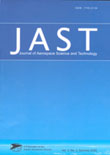فهرست مطالب

Journal of Aerospace Science and Technology
Volume:5 Issue: 4, Winter 2008
- تاریخ انتشار: 1388/09/20
- تعداد عناوین: 5
-
-
Pages 145-159
Abstract: This paper presents the effect of preload on nonlinear dynamic behavior of a rigid rotor supported by two-lobe aerodynamic noncircular journal bearing. A finite element method is employed to solve the Reynolds equation in static and dynamical states and the dynamical equations are solved using Runge-Kutta method. To analyze the behavior of the rotor center in the horizontal and vertical directions under different operating conditions, the dynamic trajectory, the power spectra, the Poincare maps and the bifurcation diagrams are used. From this study, results show how the complex dynamic behavior of this type of system comprising periodic, -periodic and quasi-periodic responses of the rotor center varies with changes in preload values by considering two bearing aspect ratio. The results of this study contribute to a better understanding of the nonlinear dynamics of two-lobe aerodynamic noncircular journal bearing system.
-
Pages 161-166Abstract: The dynamic characteristics of deflectable nose missiles with rotary single-channel control were investigated in this paper. Firstly, the effective angle of attack, effective angle of sideslip and quasi-body coordinates were introduced based on the spin characteristics of the missile’s body. Secondly, considering the interaction between the missile’s nose and body, the rigid kinetic model of missile with deflectable nose control was set up in the quasi-body coordinates utilizing rootless multi-rigid-body system dynamics. Finally, computer simulation was performed to investigate and analyze the interaction between the missile’s nose and body. Academic analysis and simulation results indicate that the nose deflection will cause a motion of body on the opposite direction, and the kinetic model established in this paper is correct and reasonable.
-
Pages 167-174Abstract: In this work the equations of motion of a Solid State Wave Gyroscope (SWG) with rotary thin cylindrical shell resonator is analyzed using the shell & plates elasticity theory. The gyroscope conversion factor found in this analytical study corresponds with the experimental results obtained and listed in the References. The function of the SWG to measure the angular velocity or the rotating angle depends on the type of resonator’s excitation. This paper analyzes two types of excitations, a positional and a parametric excitation. The former has a rate gyroscope whereas the latter has a rate integrating gyroscope. The equations of motion are solved using Bobnov-Galerkin method, where the forces produced from excitation electrodes are assumed to be the external non-conservative forces. Finally, the relationship between the input and output of the gyroscope are derived to demonstrate that the type of the excitation, determines the type of gyroscope.
-
Pages 175-182Abstract: Two 2-D aeroelastic models are presented here to determine instability boundary (flutter speed) and gust response of a typical section airfoil with degrees of freedom in pitch and plunge directions. To build these 2-D aeroelastic models, two different aerodynamic theories including Indicial Aerodynamic Theory and Vortex Lattice Method (VLM) have been employed. Also, a 3-D aeroelastic framework constructed of Boundary Element Method (BEM) and modal technique is used to show the accuracy and reliability of the presented 2-D aeroelastic models. The methods reviewed in this study are used to predict the non-dimensional flutter speed and its corresponding frequency for a typical section airfoil (for the 3-D model a high aspect ratio wing with the same cross-sectional characteristics is used) Then, a group of figures show how different time-marching schemes can change the dynamic responses due to the sharp edge gust. Also, a set of figures provide some comparisons between the 2-D aeroelastic models, and also, with the 3-D model. As seen from the results presented in this study 2-D aeroelastic models give lower non-dimensional flutter speed than the 3-D model. In addition, the dynamic responses due to the sharp edge gust predicted by the 2-D models show larger amplitudes than the 3-D model. It means that since the 2-D aeroelastic models can overestimate the dynamical behavior such as flutter speed and responses to the sharp edge gust, they can be used in the preliminary design steps to reduce the cost and save time.
-
Pages 183-190Abstract: Recent failure information from research teams in NASA Langley and others has shown that CTOA based fracture models calibrated on large C(T) and M(T) specimens can be transferred successfully to cracked aircraft fuselage structures for the assessment of their residual strength. A major difficulty that could limit the more extensive use of this failure parameter is its experimental measurement either in the real structure or in a laboratory scale test. This paper describes the use of a DCB-like specimen for direct measurement of critical CTOA data for thin sheet 2024-T3 aluminium alloy used in aeronautical applications. It outlines the features of ductile crack growth in thin walled structures, the specimen design geometry for reproducing these features in a laboratory scale experiment, the experimental set up and loading configuration for tear test specimens, and the CTOA measurement scheme. Using the test technique developed, the CTOA resistance curves for test samples of 2.3mm ligament thickness were generated for fractures propagating in the rolling and transverse direction of the original rolled plate. The results of this research showed that the technique was capable of producing large amounts of highly consistent CTOA data even from one single specimen. This is promising as it provides a precise and relatively easy experimental method for direct evaluation of CTOA toughness levels of test materials using small-scale laboratory specimens. A comparison of the test results from the current work with similar data from the literature concludes the paper.

